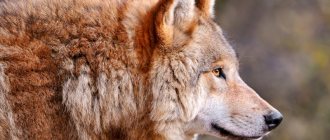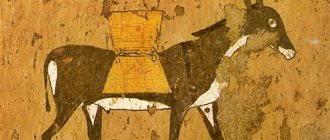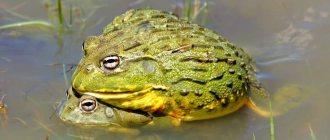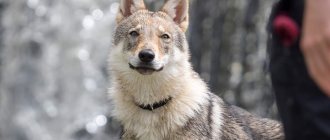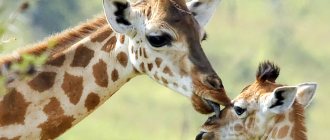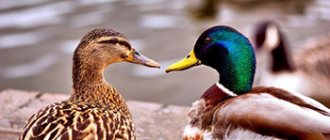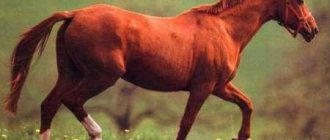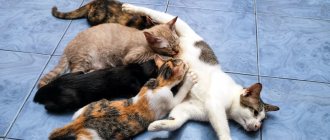Africa is a continent with an amazing climate and equally amazing animals. Despite the harsh African conditions - constant heat and many deserts - there is quite a diverse fauna here, and some of its representatives cannot be found anywhere else in the whole world! So the wild African donkey also decided to settle in this sun-scorched part of the world.
Wild African ass (Equus africanus)
This animal belongs to the equine family and is considered the ancestor of donkeys, which were tamed by humans and became domesticated. They are close relatives of the Przewalski's horse and the zebra.
Origin of the species and description
Photo: Donkey
Donkeys are equines. Their ancestors appeared at the beginning of the Paleogene: these are barylambdae and they looked more like dinosaurs than donkeys and horses - a thick animal more than two meters long, it had a short five-toed leg, which still looked a little like a hoof. From them came the Eohippus, forest-dwelling animals the size of a small dog, the number of toes was reduced to four on the front legs and three on the hind legs. They lived in North America, and mesohippus appeared there - they already had three toes on all their legs. In other ways, they also came a little closer to modern equines.
Video: Donkey
All this time, evolution proceeded rather slowly, and a key change occurred in the Miocene, when conditions changed and the ancestors of horses had to switch to feeding on dry vegetation. Then merigippus arose - an animal much taller than its closest ancestors, about 100-120 cm. It also had three fingers, but rested on only one of them - a hoof appeared on it, and the teeth also changed. Then pliohippus appeared - the first one-toed animal from this series. Due to changes in living conditions, they finally moved from forests to open spaces, became larger, and adapted to fast and long running.
Modern equids began to replace them approximately 4.5 million years ago. The first representatives of the genus were striped and had a short head, like a donkey. They were the size of a pony. The donkey was scientifically described by Carl Linnaeus in 1758 and named Equus asinus. It has two subspecies: Somali and Nubian - the former are larger and darker. It is believed that domesticated donkeys originated from crossing representatives of these subspecies.
Appearance and features
Photo: What a donkey looks like
The structure of a wild donkey is similar to that of a horse. Except that he is slightly shorter - 100-150 cm, has five lumbar vertebrae instead of six, his head is larger, and his body temperature is slightly lower. A donkey's coat is usually light gray to black. Rarely, but there are individuals of white color. The muzzle is lighter than the body, as is the belly. There is a tassel at the tip of the tail. The mane is short and erect, the bangs are small, and the ears are long. There are almost always stripes on the legs - by this feature a wild donkey can be distinguished from a domestic one, the latter do not have them.
The hooves of a donkey are noteworthy: their shape is excellent for moving over rough terrain, unlike horses’ hooves, which is why they are used for crossing mountainous terrain. But for a fast and long race, such hooves are much worse suited than those of horses, although donkeys are capable of developing comparable speeds over short distances. Origin from an arid area makes itself felt even in the case of domesticated animals: a humid climate is harmful to the hooves, cracks often appear in them, and due to the introduction of pathogenic organisms there, rotting occurs and the hooves begin to hurt. Therefore, you need to constantly care for them.
Interesting fact: In ancient Egypt, the number of donkeys a person had was used to measure his wealth. Some had a thousand heads! It was donkeys that gave a strong impetus to trade due to their ability to transport heavy loads over long distances.
THIS IS INTERESTING
It is the African wild ass that is the ancestor of the domestic donkey. Preserving this species is a very important task, because it serves as a living embodiment of history! Numerous attempts to domesticate the Asian ass have failed. Therefore, all modern domestic donkeys are descendants of African ones. Moreover, this is the very first animal that humans began to use for transporting goods. Donkeys were domesticated before horses. There is evidence that already in 4 thousand BC. In Egypt, donkeys were used as beasts of burden. About 1 thousand years BC they ended up in Greece. Hybrid forms are also widespread. For example, a mule is a hybrid of a donkey and a mare, and a hinny is a hybrid of a donkey and a stallion.
Where does the donkey live?
Photo: Wild donkey
Before our era, already in historical times, wild donkeys inhabited almost all of North Africa and the Middle East, but after domestication their range began to rapidly decline. This happened due to several factors: ongoing domestication, mixing of wild individuals with domestic ones, displacement from ancestral territories due to their development by people.
By modern times, wild donkeys remained only in the most inaccessible territories with an extremely dry and hot climate. These animals are well adapted to it, and these lands are sparsely populated, which allowed donkeys to survive. Although the decline in their numbers and shrinkage of their range continued and did not stop even in the 21st century, it is happening much more slowly than before.
By 2022, their range will include lands located in the territories of such countries as:
- Eritrea;
- Ethiopia;
- Djibouti;
- Sudan;
- Somalia.
It should be emphasized: donkeys are not found throughout the entire territory of these countries, and not even in a significant part, but only in remote areas of a small area. There is evidence that the once large population of Somali donkeys, already significantly reduced, was finally exterminated during the civil war in that country. Researchers have not yet tested whether this is true.
The situation with the other countries listed is not much better: there are very few wild donkeys living in them, so low genetic diversity is added to the problems that previously caused their numbers to decline. The only exception is Eritrea, which still has a fairly large population of wild donkeys. Therefore, according to the predictions of scientists, in the coming decades their habitat and nature will be reduced to Eritrea alone.
At the same time, it is necessary to distinguish feral donkeys from wild ones: these are once already domesticated and changed animals, then again found themselves unattended and taken root in the wild. There are many of them around the world: they are known in Europe, Asia, and North America. In Australia they have multiplied enormously, and now there are about 1.5 million of them - but they still won’t become real wild donkeys again.
Now you know where the wild donkey lives. Let's see what he eats.
Spreading
A long time ago, various subspecies of this ungulate lived in North Africa and parts of Asia. As a result of domestication, they almost all disappeared in the ancient Roman era. Today they are preserved only in the hills off the Egyptian Red Sea coast, in Ethiopia, Somalia, Sudan and Eritrea.
A small population was able to take root in the Israeli reserve. In Somalia, the wild ass may have disappeared completely as a result of the civil war. In Ethiopia and Sudan, the same fate probably awaits him too. Only Eritrea has a good population of these animals - about 400 individuals.
- 50 facts about kangaroos
- long eared hedgehog
- Cross spider
- Reptiles
- 72 facts about plants
- Animals of Siberia
What does a donkey eat?
Photo: Animal donkey
These animals are as unpretentious in nutrition as in everything else. The wild donkey eats almost any plant food that it can find in the area where it lives.
The diet includes:
- grass;
- bush leaves;
- branches and leaves of trees;
- even prickly acacia.
They have to eat almost any vegetation that they can find, because they have no choice. They often have to search for it for a long time in the poor area where they live: these are deserts and dry rocky lands, where rare stunted bushes are found every few kilometers. All oases and river banks are occupied by people, and wild donkeys are afraid to come close to populated areas. As a result, they have to live on meager food with very little nutrients, and sometimes go without food for long periods of time - and they are able to endure this with fortitude.
A donkey can starve for days and still not lose strength - domesticated ones have less stamina, but they are also inherent, and this is largely why they are valued. They can also go without water for a long time - they only need to drink once every three days. Other wild animals in Africa, like antelope and zebra, although they also live in arid conditions, need to drink daily. At the same time, donkeys can drink bitter water from desert lakes - most other ungulates are not capable of this.
Interesting fact: An animal can lose a third of its body moisture and not become weak. After finding the source, after drinking, it will immediately compensate for the loss and will not feel any negative effects.
Recommendations
This article incorporates CC BY-3.0 text from the reference. [9]
- ^ abcd Moehlman, P.D.; Kebede, F. and Johannes, H. (2015). "Equus africanus" IUCN Red List of Threatened Species
.
2015
: e.T7949A45170994. - ^ abc (in German) Heuglin Th. v & Fitzinger LJ (1866). «Systematische Übersicht der Säugethiere Nordost-Afrika's mit Einschluß der arabischen Küste, des rothen Meeres, der Somáli- und der Nilquellen-Länder, südwärts bis zum vierten Grade nördlicugen Breite. des Herrn Verfassers ergänzt und mit Zusätzen versehen von dem w. M. Dr Leopold Joseph Fitzinger." Sitzungsberichte der Kaiserlichen Akademie der Wissenschaften
, Abt. 1. Mathematisch-Naturwissenschaftliche Klasse 54: 537–611. - Jump up
↑ Grubb, P. (2005). "Order Perissodactyla". In Wilson, Delaware; Reader, D. M. (ed.). Mammal Species of the World: A Taxonomic and Geographical Guide (3rd ed.). Johns Hopkins University Press. item 629. ISBN. 978-0-8018-8221-0. OCLC 62265494. - ^ ab Staff (August 10, 2010). "African wild ass - mother of donkeys, DNA reveals". National Geographic Blogspot
. National Geographic. Archived from the original on August 17, 2010. Retrieved November 8, 2010. - ^ abc Staff. "Somali wild ass". About animals
. Saint Louis Zoo. Archived from the original on November 1, 2010. Retrieved November 8, 2010. - Azzaroli, A. (1992). "The Rise and Decline of Monodactyl Artiodactyls: A Case of Prehistoric Mass Extinction" (PDF). Anna. Zool. Finnici
.
28
: 151–163. - Orlando, L.; Ginolhac, A.; Zhang, G.; Froese, D.; Albrechtsen, A.; Stiller, M.; Schubert, M.; Cappellini, E.; Petersen, B.; and others. (July 4, 2013). "Recalibrating Equus evolution using the early Middle Pleistocene horse genome sequence". Nature
.
499
(7456): 74–8. Bibcode: 2013Natur.499…74O. DOI: 10.1038/nature12323. PMID 23803765. S2CID 4318227. - Weinstock, Jaco; Willerslev, Eske; Sher, Andrey; Tong, Wenfei; Ho, Simon Y. W.; Rubinstein, Dan; Storer, John; Burns, James; Martin, Larry; Bravi, Claudio; Prieto, Alfredo; Froese, Duane; Scott, Eric; Xulun, Lai; Cooper, Alan; Hillis, David (28 June 2005). "Evolution, systematics and phylogeography of Pleistocene horses in the New World: a molecular perspective". PLOS Biology
.
3
(8):e241. DOI: 10.1371/journal.pbio.0030241. PMC 1159165. PMID 15974804. - ^ abcdef Groves C. P. & Smeenk C. (2007). "Nomenclature of the African wild ass". Zoologische Mededelingen 81
(1). HTM Archived October 7, 2011 at the Wayback Machine, PDF Archived October 7, 2011 at the Wayback Machine - (in German) Heuglin Th. v (1861). “Th. V. Heuglin's Forschungen über die Fauna des Rothen Meeres und der Somáli-Kuste. Ein systematisches Verzeichniss der Säugethiere und Vögel, welche in diesen Regionen bisher beobachtet worden sind, mit Rücksicht aufalerreitungis.” Mittheilungen aus Justus Perthes 'Geographischer Anstalt über Wichtige Neue Erforschungen auf dem Gesammtgebiete der Geographie von Dr A. Petermann ("Petermann's Geographische Mittheilungen")
: 11–32. - (in German) Noack Th. (1884). "Neues aus der Tierhandlung von Karl Hagenbeck, sowie aus dem Zoologischen Garten in Hamburg." Zoological Garden 25
: 100–115. - ""Somali Wild Ass" in the Marvell Animal Encyclopedia". marwell.org.uk
. - ^ abc "African wild ass". Information about animals.
- ^ abc Reyes, E. "The African Wild Ass". An absolute hoofed animal.
- Clutton-Brock, Juliet (1992). Horse Power: The History of the Horse and Donkey in Human Societies
. USA: Harvard University Press. ISBN 978-0-674-40646-9. - "Basel Zoo". Zoobasel.ch. Archived from the original on December 20, 2013. Retrieved February 16, 2013.
- "Basel Zoo". Zoobasel.ch. Archived from the original on December 20, 2013. Retrieved February 16, 2013.
- "Basel Zoo welcomes endangered Somali wild ass". ZooBorns
.
Features of character and lifestyle
Photo: Female donkey
The time of activity is dictated by nature itself - during the day it is hot, and therefore wild donkeys rest, finding a place in the shade and, if possible, cooler. They come out of hiding and start looking for food at dusk and do this all night. If they fail to refresh themselves, they can continue with the onset of dawn. In any case, this does not last long: soon it becomes hot, and they still have to find shelter so as not to lose too much moisture due to the scorching sun.
A donkey can do all this either alone or as part of a herd. Often, moving in one direction night after night, wild donkeys wander long distances. They do this in search of places more abundant in vegetation, but their wanderings are limited by civilization: having stumbled upon places developed by humans, they turn back to their wild lands. At the same time, they move slowly so as not to overheat and not waste too much energy.
The need to save energy is so ingrained in their minds that even the descendants of long-domesticated animals move in the same leisurely manner, and it is very difficult to induce a donkey to increase its speed, even if it is well fed and watered in cool weather. They have excellent eyesight and hearing; previously they were necessary against predators: donkeys noticed hunters from afar and could flee from them. There were rare moments when they developed high speeds - up to 70 km/h.
There are now almost no predators in their range, but they remain very cautious. Individuals living alone are territorial: each donkey occupies an area of 8-10 square kilometers and marks its boundaries with dung heaps. But even if a relative violates these boundaries, the owner usually does not show aggression - at least until the aggressor decides to mate with his female.
Social structure and reproduction
Photo: Pair of donkeys
Wild donkeys live both alone and in herds of several dozen individuals. Solitary animals often gather in groups near water bodies. There is always a leader in the herd - the largest and strongest, no longer young donkey. There are usually many females with him - there can be about a dozen of them, and young animals. Females reach sexual maturity by three years, and males by four. They can mate at any time of the year, but most often do it in the spring. During the mating period, males become aggressive; single individuals (“bachelors”) can attack the leaders of the herd in order to replace them - only then will they be able to mate with the females of the herd.
But the fights are not very cruel: during their course, opponents usually do not receive mortal wounds, and the loser leaves to continue to lead a solitary lifestyle and try his luck next time, when he gets stronger. Pregnancy lasts more than a year, after which one or two cubs are born. The mother feeds the young donkeys with milk for up to 6-8 months, then they begin to feed on their own. They can remain in the herd until they reach sexual maturity, then the males leave it - to start their own or wander alone.
Interesting fact: This is a very loud animal, its calls during mating season can be heard from a distance of more than 3 km.
In captivity
There are approximately 150 individual Somali wild asses living in zoos around the world, of which 36 were born at Basel Zoo,[16] where this type of breeding program began with the first Basel Somali wild asses in 1970 and the first births in 1972.[ 17]
Zoo Basel maintains the European Studbook for the Somali Wild Ass and coordinates the European Endangered Species Program (EEP). [18] All European and American wild asses are descendants of the original group at Basel Zoo or 12 others that arrived from the Yotvata Hai-Bar Nature Reserve in Israel in 1972.
Natural enemies of donkeys
Photo: What a donkey looks like
Donkeys used to be hunted by lions and other large cats. However, in the area where they now live, neither lions nor other large predators are found. These lands are too poor and, as a result, inhabited by little prey. Therefore, in nature, a donkey has very few enemies. It is rare, but still possible, that wild donkeys meet predators: they are able to notice or hear the enemy at a fairly large distance, and are always on alert, so it is difficult to take them by surprise. Realizing that he is being hunted, the wild donkey quickly runs away, so that even lions have difficulty keeping up with him.
But he cannot maintain high speed for a long time, therefore, if there is no shelter nearby, he has to come face to face with the predator. In such a situation, donkeys desperately fight back and are even capable of causing serious damage to the attacker. If a predator has set its sights on a whole flock, then it is easiest for him to overtake even small donkeys, but adult animals usually try to protect their herd. The main enemy of wild donkeys is man. It is because of people that their numbers have decreased so much. The reason for this was not only displacement into increasingly remote and infertile lands, but also hunting: donkey meat is quite edible, and local residents in Africa consider it medicinal.
Interesting fact: Stubbornness is considered a shortcoming of donkeys, but in fact the reason for their behavior is that even domesticated individuals still have the instinct of self-preservation - unlike horses. Therefore, the donkey cannot be driven to death; he has a good sense of where the limit of his strength is. So a tired donkey will stop to rest, and it will not be possible to move him from his place.
Population and species status
Photo: Black Donkey
The species has long been listed in the Red Book as critically endangered, and its overall population has only decreased further since then. There are different estimates: according to optimistic data, there may be up to 500 wild donkeys in total in all areas where they live. Other scientists consider the figure of 200 individuals to be more accurate. According to the second estimate, all populations except the Eritrean one have died out, and those wild donkeys that are occasionally seen in Ethiopia, Sudan, and so on, are in fact no longer wild, but their hybrids with wild ones.
The decline in the population was primarily due to the fact that people occupied all the main watering places and pastures in the places where donkeys lived before. Despite the adaptability of donkeys to the harshest conditions, it is very difficult to survive in the areas where they now live, and she simply could not feed a large number of these animals. Another problem for the conservation of the species: a large number of feral donkeys.
They live on the edge of the range of real wild donkeys, and interbreed with them, as a result of which the species degenerates - their descendants can no longer be classified as wild donkeys. An attempt was made to acclimatize in the Israeli desert - so far it has been successful, the animals have taken root in it. There are chances that their population will begin to grow, especially since this territory is part of their historical range.
Kulans today
It's no secret that most animal species were exterminated by humanity, and were preserved by them. With the help of nature reserves, animals such as kulans have been preserved to this day. It is very important for people to preserve wild and untameable animals that are interesting and mysterious from the point of view of nature. These donkeys demonstrate the resilience of life, unpretentiousness and tenacity of their character.
Today, most scientists have set themselves the goal of taming kulans and, with their help, developing a new type of domestic animal. So far, most of the goals have remained at the planning stage, since the kulans persistently maintain their independence and love of freedom. Today it is very important to preserve these animals, since in ancient times humanity hunted them en masse, exterminating them in herds, so at the moment they are listed in the Red Book.
